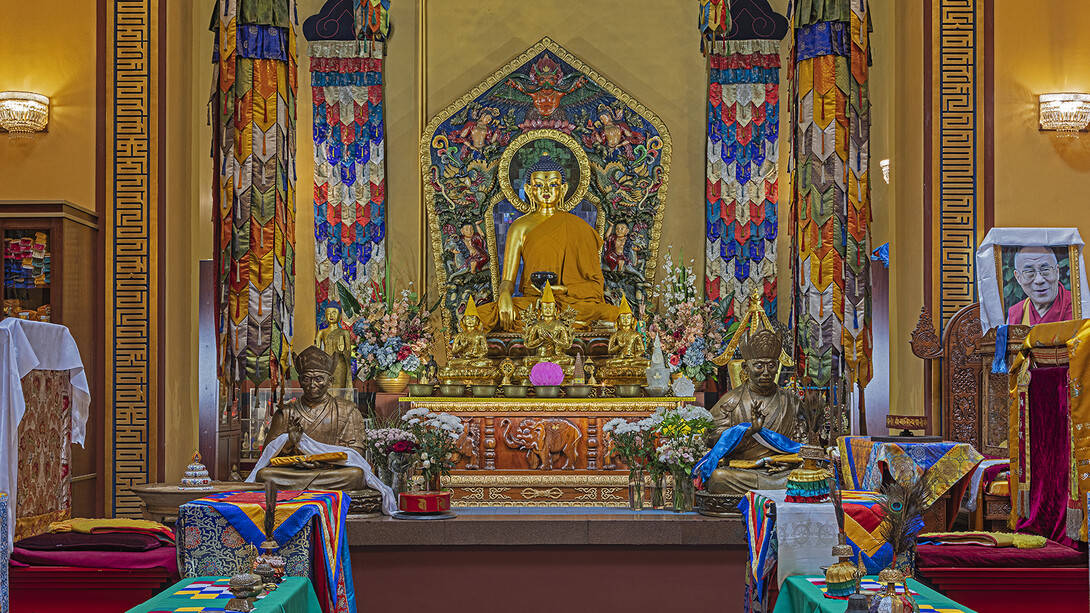Buddhism is one of Russia’s traditional religions. Buddhist culture is an important part of Saint Petersburg culture of the Silver Age, which found embodiment in the creation of the Saint Petersburg Buddhist temple and political links with Tibet at the court of the last emperor, in the brilliant Petersburg school of Buddhist studies of Feodor Shcherbatsky, Sergei Oldenburg and many others. Rich Saint Petersburg collections were assembled by people with prominent names: Prince Esper Ukhtomsky, Piotr Kozlov – the discoverer of Khara-Khoto, Agathon Fabergé, George de Roerich… The Hermitage preserves and reproduces those cultural ties in refurbished displays and exhibitions both in the Winter Palace and at Staraya Derevnya – close to our Datsan, in honour of whose 110th anniversary we have created this exhibition, full of information about the details of complex Buddhist ritual.
(Mikhail Piotrovsky, General Director of the State Hermitage, comments)
The exhibition The jewel in the lotus is a continuation of the “Abode of Charity” project that was successfully implemented at the Hermitage in 2015–16. The new display has an entirely different composition. Many of the works will be on show for the first time.
The title of the exhibition is a translation of the main Tibetan mantra – Om mani padme hum – devoted to the Bodhisattva Avalokiteshvara, who symbolizes boundless mercy and compassion.
The display presents around 500 works of art: bronze sculpture, traditional Tibetan thangka painting, wooden blocks for printing texts and miniature relief images (tsa-tsa). In the exhibition it will also be possible to see ritual objects and masks belonging to the Cham Buddhist mystery1 from Mongolia, Ladakh and Sikkim.
An important part of the display tells the story of the construction of the Saint Petersburg Datsan Gunzechoinei Buddhist Temple, which was built in 1909–15 on the initiative of the scholarly lama Agvan Lobsang Dorzhiev (1853–1938). The Datsan’s architecture is a unique synthesis of Tibetan traditions and the European Art Nouveau style.
Some of the exhibits, including photographs, drawings and small sculptures, have been provided by the collector Igor Dmitriyevich Mikhailovsky.
The Hermitage exhibition is a large-scale visual narrative about the philosophy of Tibetan Buddhism. The display not only presents artistic masterpieces, but also vividly demonstrates the influence that Tibetan culture has had. Artefacts collected by Russian scholars, Orientalists and travellers became an important part of our country’s cultural heritage.
A scholarly illustrated catalogue has been produced for the exhibition: "Dragotsennost’ v lotose": iskusstvo tibetskogo buddizma. K 110-letiiu Sankt-Peterburgskogo buddiiskogo khrama "Datsan Gunzechoinei" (State Hermitage Publishing House, 2025).
The curator of the exhibition and author of the catalogue is Yulia Igorevna Yelikhina, leading researcher in the State Hermitage’s Oriental Department, Keeper of the Mongolian, Tibetan and Khotan collections, associate professor of Mongol and Tibetan Studies at Saint Petersburg State University, Candidate of Historical Sciences, Doctor of Culturology.
Notes
1 The Cham is a ceremonial Buddhism mystery of dance and music that is performed at major monasteries in Tibet, Ladakh, Sikkim and Buryatia.
















